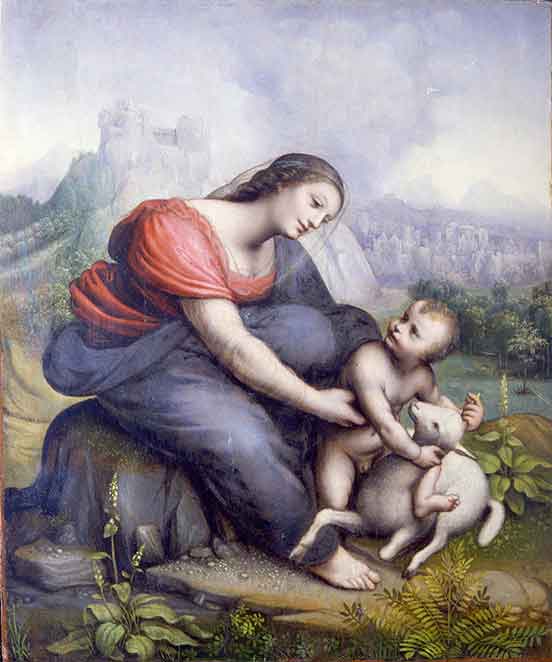Madonna and Child with the Lamb
Cesare da Sesto , ca. 1515
Description

This small panel reproduces, with some variants, the famous painting by Leonardo da Vinci “Saint Anne, the Virgin and Child with the Lamb”, now in the Louvre. Leonardo worked on this painting for a long time, producing his first studies for it around 1501 and completing it, probably in Milan, between 1510 and 1513. Even as a cartoon, Leonardo’s composition became very popular, and many were the contemporary copies and variants, still existing.
In the Poldi Pezzoli painting, made for private devotion, the figure of Saint Anne is missing, probably at the patron’s request. and the landscape is different. The architecture of the town on the right and of the castle on the left show Nordic elements, perhaps French, maybe in honour of the new rulers of Milan.
The peculiar cold colouring with its tones of blue and the elegant reinterpretation of Leonardo’s model in the style of Raphael confirm the attribution to Cesare da Sesto.
The panel dates to the end of 1515, when the artist returned to Milan after a long journey through central and southern Italy, where he had seen Raphael’s works. The detailed rendering of the vegetation in the foreground is probably by Bernardino Bernazzone, who collaborated with Cesare da Sesto also for other works.
The two plants with tubular pendent flowers are digitalis, officinal plants. On the right is depicted the gallium, with compound leaves and without flowers.
Data Sheet
Author
Cesare da Sesto, 1477 – 1523
Date
ca. 1515
Material and technique
Tempera on panel
Measures
37 cm x 30 cm
Acquisition
Gian Giacomo Poldi Pezzoli bequest, 1879
Inventory number
1617
location
Lombard Rooms
The three rooms display Lombard paintings of the Renaissance, made during the years (1450-1535) when Milan and Lombardy were ruled by the Sforzas, who gave birth to one of the most splendid courts in Europe. They are mostly panels for private devotion, purchased by Gian Giacomo Poldi Pezzoli in the later 19th century.
Beginning in 1450, Vincenzo Foppa helped give a new identity to Lombard art, and this renewal was joined in the last quarter of the 15th century by the presence in Milan of the Urbino architect Donato Bramante and the Florentine Leonardo da Vinci
Thanks to Leonardo, an artistic school developed that drew from his teachings the skilful use of sfumato, the careful study of nature, and the rendering of movement and the motions of the figures’ souls.
The rooms feature works by both his pupils such as Giovanni Antonio Boltraffio, Marco d’Oggiono, and artists who compared themselves with him such as Bernardo Zenale, Giampietrino, Cesare da Sesto, Andrea Solario, and Bernardino Luini.
Since 1951 the tablets that decorated Palazzo Vimercati in Crema (c. 1500) have been displayed on the ceiling. They were a typical decoration on the ceilings of public and private buildings in Lombardy between the Gothic and Renaissance periods.
The new lighting was provided by the Associazione Amici del Museo Poldi Pezzoli.
collection
Paintings
The Museum hosts over 300 paintings. Among them, many Italian works from the Renaissance: masterpieces from Tuscany (Botticelli, Piero della Francesca, Pollaiuolo), Lombardy (Luini, Boltraffio, Solario) and Veneto (Bellini, Mantegna). Important is also the group of 18th century Italian painting (Guardi, Canaletto, Tiepolo, Fra Galgario). In the collection, there are mainly portraits and small size paintings.
